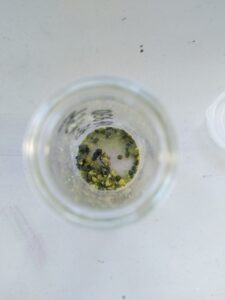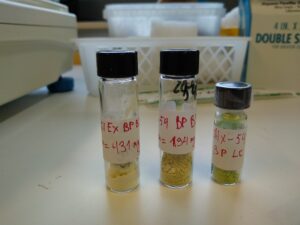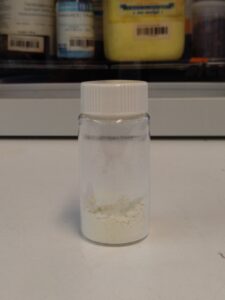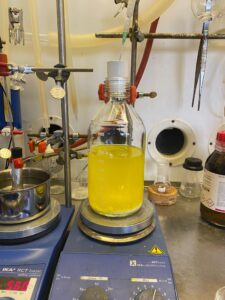The Pihko group at JYU focuses on the chemical synthesis of new materials that could be utilized
to store energy in flow batteries. We start from natural products, such as vitamins, that possess the
requisite properties as starting materials for the synthesis. After several chemical steps and
purifications, we arrive at chemically modified molecules whose stability in the chemical reactions
that take place in the battery will then be tested. We have recently identified a key molecule that
appears to meet the necessary requirements and are now exploring improved routes for the
chemical synthesis as well as simpler versions of the molecule.
We have recently identified a key redox-active candidate that appears to meet the necessary
requirements and are now exploring improved routes for the chemical synthesis as well as simpler
versions of the molecule. The newly synthesized materials are solids and readily dissolve in water.
Work to improve their purification and scaling up the synthesis is under way.




The JYU team has made an interesting breakthrough in the chemical synthesis of bioinspired molecules for
redox flow batteries, the topic of WP4 in COMPBAT. We have now identified a pyridoxal-based molecule
that appears to be stable over 50 redox cycles in aqueous media, but at present only at high pH. The key to
this success lies in protecting one of the anionic groups in the molecule – without this protection, the
molecules were unstable irrespective of pH. We are currently expanding on this finding with newly
designed molecules that retain the protective group but include groups that should be stable in lower pH.
The current hypotheses behind the stability issues will be tested with these new materials.
The JYU team has developed a relatively robust synthetic route to these water-soluble flow battery
materials, and is currently also engaged in scaling up the production from milligram to gram scale. Several
bottlenecks and setbacks in the synthesis have been identified and the problems have been circumvented.
We have also provided materials for the electrochemical testing of the synthesized materials, in
collaboration with the UTU team. These experiments have provided important and decisive feedback and
they will now guide our synthetic efforts as they have provided key data on the stability of the materials
under different conditions. We have also been engaged in developing and expanding the computational
sets with new molecules in WP1 and the most recent additions to these sets include new molecules based
on the current hypotheses for stability.
